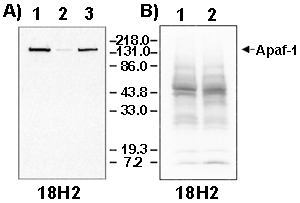Product Details
| Alternative Name: | Apoptosis protease-activating factor 1 |
| |
| Clone: | 18H2 |
| |
| Host: | Rat |
| |
| Isotype: | IgG2a |
| |
| Immunogen: | Recombinant mouse Apaf-1 (apoptosis protease-activating factor-1) (aa 1-97) containing the N-terminal CARD domain. |
| |
| UniProt ID: | O88879 |
| |
| Species reactivity: | Human, Mouse
|
| |
| Specificity: | Recognizes the CARD domain of Apaf-1. |
| |
| Crossreactivity: | Does not cross-react with rat Apaf-1. |
| |
| Applications: | ELISA, ICC, IP, WB
|
| |
| Formulation: | Liquid. Protein G purified antibody in PBS containing 0.02% sodium azide. |
| |
| Handling: | Avoid freeze/thaw cycles. |
| |
| Shipping: | Blue Ice |
| |
| Short Term Storage: | +4°C |
| |
| Long Term Storage: | -20°C |
| |
| Regulatory Status: | RUO - Research Use Only |
| |

Figures: Species cross-reactivity of MAb to Apaf-1 (clone 18H2) (
ALX-804-350) by Western blot.
A: Lysates from 1-day-old
mouse brain (lane 1), adult
mouse brain (lane 2) and SH-SY5Y
human neuroblastoma cell line (lane 3) were probed with clone 18H2.
B: Lysates from 2-days-old
rat brain (lane 1) and adult
rat brain (lane 2) were probed with clone 18H2.
Results: 18H2 is human and mouse specific but does not recognize rat Apaf-1."

Figure: Species cross-reactivity of MAbs to APAF-1 by WB. left: Lysates from 1-day-old mouse brain (lane 1), adult mouse brain (lane 2) and SH-SY5Y human neuroblastoma cell line (lane 3). right: Lysates from 2-days-old rat brain (lane 1) and adult rat brain (lane 2).
Please mouse over
Product Literature References
Apaf-1 and caspase-9 are required for cytokine withdrawal-induced apoptosis of mast cells but dispensable for their functional and clonogenic death: V.S. Marsden, et al.; Blood
107, 1872 (2006),
Abstract;
Full Text
Apaf-1 and caspase-9 do not act as tumor suppressors in myc-induced lymphomagenesis or mouse embryo fibroblast transformation: C.L. Scott, et al.; J. Cell Biol.
164, 89 (2004),
Abstract;
Full Text
Pro-apoptotic apoptosis protease-activating factor 1 (Apaf-1) has a cytoplasmic localization distinct from Bcl-2 or Bcl-x(L): G. Hausmann, et al.; J. Cell Biol.
149, 623 (2000),
Abstract;
Full Text
General Literature References
Apaf1 in developmental apoptosis and cancer: how many ways to die?: F. Cecconi & P. Gruss; Cell. Mol. Life Sci.
58, 1688 (2001), (Review),
Abstract;
Pro-apoptotic apoptosis protease-activating factor 1 (Apaf-1) has a cytoplasmic localization distinct from Bcl-2 or Bcl-x(L): G. Hausmann, et al.; J. Cell. Biol.
149, 623 (2000),
Abstract;
Full Text
Apaf1 (CED-4 homolog) regulates programmed cell death in mammalian development: F. Cecconi, et al.; Cell
94, 727 (1998),
Abstract;
Bcl-XL interacts with Apaf-1 and inhibits Apaf-1-dependent caspase-9 activation: Y. Hu, et al.; PNAS
95, 4386 (1998),
Abstract;
Full Text
Apaf-1, a human protein homologous to C. elegans CED-4, participates in cytochrome c-dependent activation of caspase-3: H. Zou, et al.; Cell
90, 405 (1997),
Abstract;
Cytochrome c and dATP-dependent formation of Apaf-1/caspase-9 complex initiates an apoptotic protease cascade: P. Li, et al.; Cell
91, 479 (1997),
Abstract;












